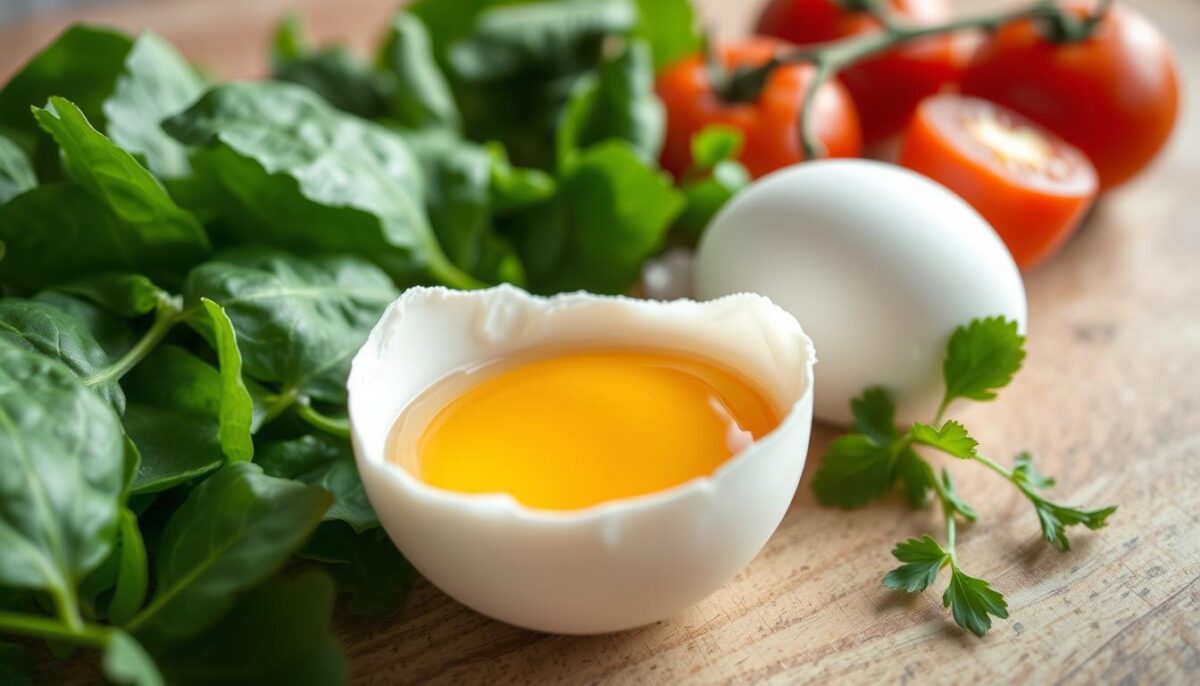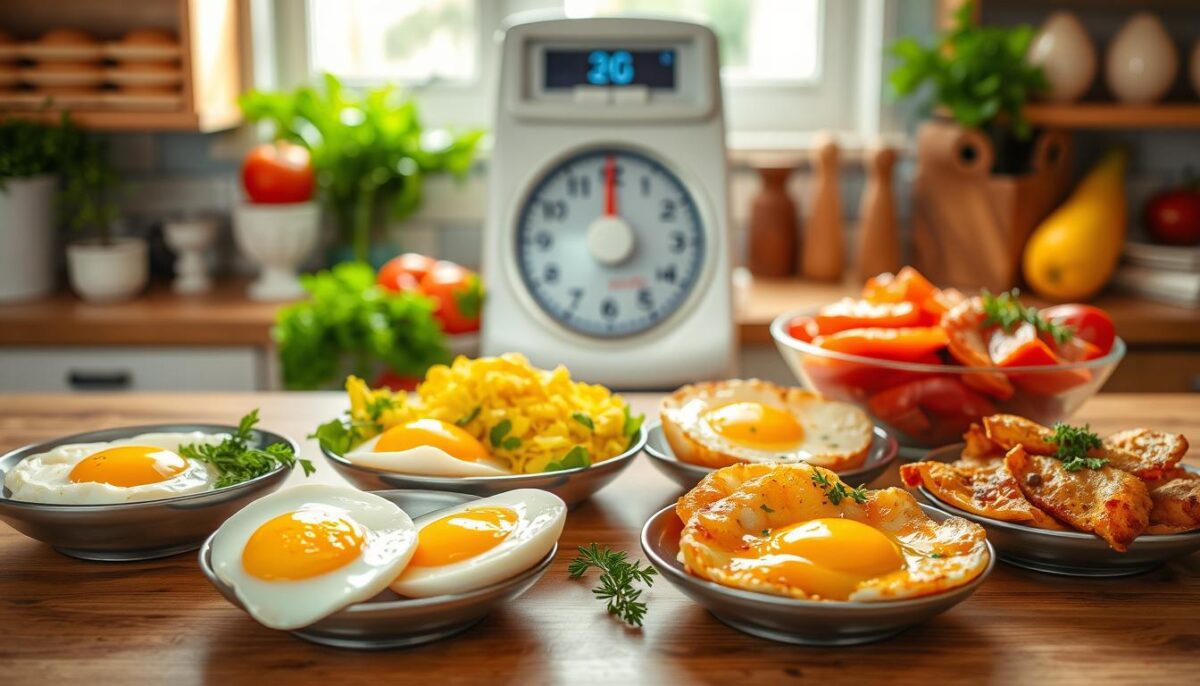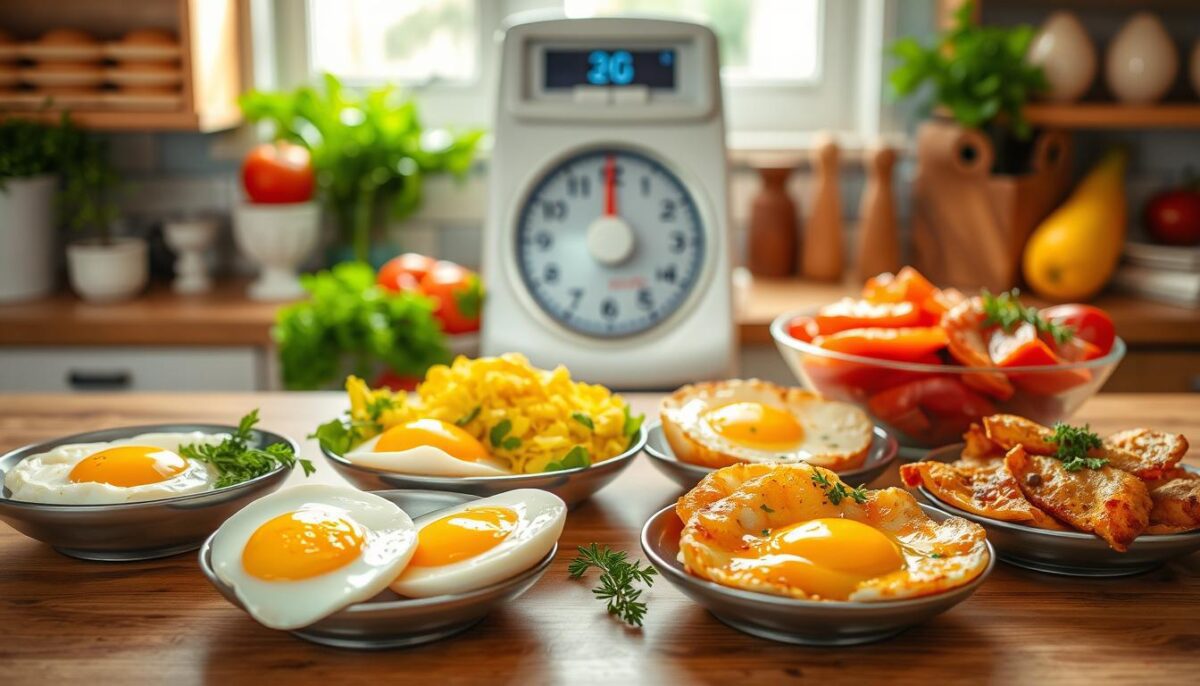Many of us wonder why the calorie content of cooked eggs increases. The science behind cooking provides a clear explanation. Understanding how cooking alters the calorie content of eggs is essential for making informed dietary choices.
The calorie content of eggs plays a significant role in their overall nutritional value. Different cooking methods can impact this. In this article, we’ll explore why the calorie content of cooked eggs changes and delve into the science of nutrition and cooking techniques.
By understanding how cooking affects the calorie content of eggs, we can better appreciate the role of cooking methods in enhancing or altering their nutritional value, helping us make smarter dietary decisions.

1. Understanding Raw Egg Nutrition
Egg nutrition facts show that raw eggs are packed with important nutrients. These include proteins, vitamins, and minerals. Raw eggs have about 70 calories, 6 grams of protein, and 5 grams of fat.
The way our body absorbs nutrients from raw eggs is key. Nutritional changes happen when we eat eggs raw. For example, the protein in raw eggs is very easy for our body to use. This makes it a great source of essential amino acids.
Basic Nutritional Composition
Raw eggs are full of vitamins and minerals. They have vitamin D, vitamin B12, and iron. Here’s a table showing the main nutrients in raw eggs:
| Nutrient | Amount per large egg |
|---|---|
| Calories | 70 |
| Protein | 6 grams |
| Fat | 5 grams |
| Vitamin D | 6% of the Daily Value (DV) |
| Vitamin B12 | 10% of the DV |
| Iron | 5% of the DV |
Bioavailability in Raw Form
It’s important to think about how our body uses nutrients from raw eggs. The bioavailability of nutrients in raw eggs can change. This is due to enzyme inhibitors and the egg’s natural structure.
Safety Considerations of Raw Eggs
Raw eggs can be good for you, but safety is key. They can have salmonella, which is a risk. So, it’s important to handle and store them safely.
2. Why Do Eggs Increase in Calories When Cooked?
Cooking eggs affects their calorie content in interesting ways. When eggs are heated, the proteins undergo a structural change, making them easier for the body to digest. This process increases the number of calories the body absorbs from cooked eggs compared to raw ones.
For instance, boiled eggs contain more digestible calories than raw eggs due to the way heat alters the protein structure. Similarly, the cooking method influences the calorie count. Frying or poaching eggs tends to make them more calorie-dense, as these methods often involve added fats or oils.
Here are some key factors that contribute to the increase in calories when eggs are cooked:
- Denaturation of proteins: Heat causes proteins to unwind and reorganize, making them more easily digestible.
- Improved digestibility: Cooked eggs are easier for the body to absorb, resulting in a higher calorie intake.
- Egg preparation method: Different cooking methods can affect the calorie content of eggs.
Knowing how cooking affects egg calories helps us make better choices. By understanding these changes, we can enjoy eggs while keeping our calorie intake in check.
3. The Science of Protein Denaturation in Eggs
When eggs are cooked, heat causes proteins to denature. This changes the egg’s structure. It also affects how proteins are digested and absorbed, impacting egg nutrition.
Cooking eggs can make some nutrients more available. But overcooking can reduce their nutritional value. Finding the right balance is key to enjoying eggs safely and nutritionally.
- Cooking method: Different cooking methods, such as boiling, frying, or poaching, can affect the extent of protein denaturation and heat-induced changes.
- Cooking time: The duration of cooking can impact the nutritional value of the eggs, with overcooking leading to a decrease in nutrient availability.
- Temperature: The temperature at which the eggs are cooked can also influence the degree of protein denaturation and heat-induced changes.
Understanding protein denaturation helps us choose the best cooking methods. This way, we can enjoy eggs that are both safe and nutritious.

4. Measuring Caloric Differences Between Raw and Cooked Eggs
To understand how cooking changes eggs, it’s essential to examine the calorie content of cooked eggs compared to raw eggs. Different cooking methods significantly affect the nutritional value and calorie content of eggs. By exploring these differences, we can make more informed dietary choices.
When we measure caloric differences, the cooking method plays a crucial role. For example, boiling or poaching eggs tends to preserve more nutrients, whereas frying or scrambling often results in higher calorie content due to added fats. Understanding the calorie content of cooked eggs and how it varies with preparation methods is key to maximizing their health benefits.
Key factors to consider when evaluating the calorie content of cooked eggs include:
- The original calorie content of raw eggs
- The impact of cooking methods on nutrient retention
- The resulting nutritional changes and how they influence the egg’s overall value
By carefully considering these elements, we gain a better understanding of how cooking affects both the calorie content and nutritional profile of eggs. This knowledge empowers us to make smarter decisions about incorporating eggs into a healthy, balanced diet.
5. Different Cooking Methods and Their Impact on Calories
The calorie content of cooked eggs can vary significantly depending on the cooking method used. Some methods are healthier than others, making it essential to understand how different techniques affect calorie levels and overall nutrition.
Methods such as boiling, frying, and scrambling have notable effects on the calorie content of eggs. For instance, boiling eggs is one of the healthiest options, as it preserves more nutrients without adding extra fats or oils. On the other hand, frying and scrambling often lead to increased calories due to the use of oils and fats. Poaching and steaming are excellent alternatives for keeping the calorie content of cooked eggs low while maintaining their nutritional value.
Here are some key points about the calorie content of cooked eggs based on different preparation methods:
- Boiling: Soft-boiled eggs generally result in fewer calorie changes compared to hard-boiled eggs.
- Frying and Scrambling: These methods can significantly increase calorie content because of added oils and fats.
- Poaching and Steaming: These techniques retain the eggs’ nutritional value and minimize calorie changes, making them ideal for a healthy diet.
Understanding the calorie content of cooked eggs is crucial for making healthier dietary choices. By selecting the right cooking method, you can enjoy eggs as part of a balanced diet. Whether you prefer boiling, frying, or poaching, the method you choose plays a significant role in the nutritional profile of your egg dishes. Choose wisely to align with your health goals!

6. The Role of Added Ingredients in Egg Preparation
Added ingredients can significantly change the calorie content of cooked eggs. Salt, pepper, cheese, and veggies may enhance flavor but also add calories. Understanding how these additions impact our diet is key to making informed choices.
In egg preparation, adding milk, cream, or butter increases the calorie count. However, ingredients like spinach, mushrooms, and bell peppers boost fiber and vitamins without overloading on calories. It’s about finding the right balance for a healthy meal.
Omelets and frittatas are perfect examples of dishes that use added ingredients to enhance taste and texture. Choosing wisely allows us to create flavorful yet nutritious meals. For instance, adding turmeric and garlic to scrambled eggs not only improves flavor but also provides additional health benefits. Opting for whole wheat bread in egg sandwiches adds a fiber boost, making the dish more balanced.
Here are some tips for making smart choices about added ingredients in egg preparation:
- Choose fresh and whole ingredients whenever possible.
- Be mindful of portion sizes to avoid excessive calorie intake.
- Experiment with a variety of ingredients to find healthy, delicious combinations.
By focusing on the calorie content of cooked eggs and the impact of added ingredients, we can transform simple dishes into nutritious, balanced meals. Whether it’s a quick omelet or a gourmet frittata, the right ingredients truly make a difference in creating healthy, satisfying meals.
7. Nutritional Benefits of Cooked Eggs
Cooked eggs are a powerhouse of nutrients, making them an excellent choice for a healthy diet. They offer enhanced protein availability when cooked, as heat makes the proteins easier for our bodies to process. This is especially beneficial for active individuals or those aiming to build muscle. Plus, the calorie content of cooked eggs is relatively low, making them an ideal option for those managing their calorie intake.
Cooking eggs also improves mineral absorption. Heat breaks down zinc and iron, making these vital minerals easier for the body to utilize. This is particularly valuable for individuals who may lack sufficient amounts of these essential nutrients in their diet. Additionally, the calorie content of cooked eggs ensures you can enjoy their nutritional benefits without overindulging.
Key Nutritional Benefits:
- Enhanced protein availability for better muscle growth and repair
- Improved mineral absorption, including zinc and iron
- Vitamin retention rates, ensuring cooked eggs remain a rich source of essential vitamins
Packed with vitamins and minerals, cooked eggs are a delicious and versatile choice for anyone striving to improve their health. Whether you prefer them boiled, scrambled, or in an omelette, cooked eggs provide a nutrient-dense and calorie-conscious addition to your meals.
8. Best Cooking Practices for Maximum Nutrition
To get the most out of your eggs, it’s key to use cooking practices that keep their nutrients. This means gentle heat, short cooking times, and healthy methods. A bit of care in egg preparation can make a big difference in keeping nutrients.
Here are some tips for getting maximum nutrition from eggs:
- Use poaching or steaming instead of frying
- Cook eggs for the shortest time needed
- Stay away from high-heat cooking
By sticking to these cooking practices, your eggs will keep their nutritional value. This means you’ll get the most maximum nutrition possible. Whether you’re making scrambled eggs, an omelette, or a frittata, healthy egg preparation is key.
The secret to getting the most from your eggs is gentle heat, short cooking times, and healthy methods. By following these tips, you can enjoy tasty and nutritious eggs. These eggs will help you stay healthy and full of energy.

9. Common Myths About Egg Calories and Cooking
There are many myths about egg calories and cooking. It’s important to know the truth to make good diet choices. One myth is that cooking eggs makes them much higher in calories. But, the truth is, cooking eggs only slightly increases their calories.
Some think frying eggs makes them much higher in calories. But, adding oil or butter does increase calories. Still, eggs themselves don’t get much higher in calories from cooking. It’s key to know the facts and look at scientific evidence.
Debunking Popular Misconceptions
Many believe poaching or boiling eggs is the healthiest way. But, all cooking methods have their own good and bad sides. Cooking myths can be confusing. It’s important to trust scientific evidence when choosing what to eat.
Scientific Evidence Explained
The calorie count of eggs stays pretty much the same, no matter how you cook them. Adding things like oil, butter, or cheese can increase calories. Knowing the nutritional value of eggs and how cooking affects calories is key. By clearing up myths and looking at facts, we can make better choices and enjoy eggs in a healthy way.
Some important points to remember about egg calories and cooking myths are:
- Understanding the nutritional value of eggs
- Knowing how different cooking methods affect egg calories
- Staying away from myths and trusting scientific evidence
10. Incorporating Cooked Eggs into a Healthy Diet
Cooked eggs are a tasty and nutritious addition to a healthy diet, but it’s important to watch your portions to maintain balance. Eating cooked eggs can significantly boost your protein intake and help your body retain essential vitamins.
To incorporate cooked eggs into your meals, focus on balance and variety. Cooked eggs are an excellent source of protein, and their benefits are enhanced when paired with nutrient-rich foods. For more tips, check out this guide on healthy egg-eating tips for optimal nutrition. Here are some ideas to get started:
- Pair cooked eggs with whole grains, like brown rice or whole-wheat toast, for a nutritious breakfast.
- Add cooked eggs to salads or stir-fries for a protein-packed and delicious meal.
- Use cooked eggs as a topping for veggies or whole-grain crackers for a healthy snack.
For portion sizes, aim for 2–3 cooked eggs per serving. This helps you meet your protein needs without overloading on calories. By following these tips you can enjoy the many health benefits of eggs while maintaining a balanced diet.
11. Special Considerations for Different Dietary Needs
When we add eggs to our diet, we need to think about our special considerations. This is true for vegetarians, vegans, and those on gluten-free or low-carb diets. Eggs can be a great addition to our meals.
Eggs are packed with protein, vitamins, and minerals. They’re perfect for vegetarians because they’re a great protein source. Plus, eggs fit well into a gluten-free diet since they don’t have gluten.
It’s key to think about special considerations for different diets. For example:
- Vegetarians and vegans should choose eggs from organic or free-range hens.
- Those on gluten-free diets need to make sure any added foods, like bread or pasta, are gluten-free.
- Low-carb dieters can enjoy eggs with veggies like spinach or mushrooms.
By keeping these special considerations in mind, people with various dietary needs can still get the benefits of eggs. This way, they can keep their diet balanced and healthy.
12. The Recipe
Print
Shakshuka with Poached Egg
- Total Time: 30 minutes
- Yield: 2-4 servings
Description
Shakshuka is a delightful blend of bold Mediterranean flavors and hearty ingredients, making it a versatile dish perfect for any meal of the day. Eggs poached in a fragrant spiced tomato sauce create a harmonious balance of textures and tastes.
This dish is as stunning as it is delicious. The rich red hues of the sauce contrast beautifully with the golden yolks and fresh green herbs. It’s perfect for sharing with loved ones, paired with crusty bread for dipping or a sprinkle of feta cheese for extra tang. Shakshuka is a comforting yet healthy option, ideal for brunch, dinner, or a flavorful weeknight treat.
Ingredients
– 4 large eggs
– 2 tablespoons olive oil
– 1 medium onion, finely chopped
– 2 garlic cloves, minced
– 1 bell pepper, diced
– 1 teaspoon ground cumin
– 1 teaspoon smoked paprika
– 1/4 teaspoon chili flakes (optional)
– 1 can (14 oz) crushed tomatoes
– Salt and pepper to taste
– Fresh parsley or cilantro, chopped, for garnish
– Optional: feta cheese or crusty bread for serving
Instructions
1. Heat olive oil in a large skillet over medium heat. Add the onion and sauté until soft and translucent, about 3-4 minutes.
2. Add the garlic and bell pepper. Cook for another 3-4 minutes, stirring occasionally.
3. Sprinkle in the cumin, smoked paprika, and chili flakes. Stir for 30 seconds to release their aroma.
4. Pour in the crushed tomatoes and season with salt and pepper. Stir well, reduce the heat to low, and simmer for 10-12 minutes until the sauce thickens slightly.
5. Using the back of a spoon, make 4 small wells in the tomato sauce. Crack an egg into each well, being careful not to break the yolks.
6. Cover the skillet and cook for 5-7 minutes or until the egg whites are set but the yolks remain runny.
7. Remove from heat, garnish with fresh parsley or cilantro, and serve immediately with feta cheese and crusty bread if desired.
- Prep Time: 10 minutes
- Cook Time: 20 minutes
FAQ
Why do eggs increase in calories when cooked?
Cooking eggs, like boiling or frying, changes their proteins. This change, called denaturation, makes the proteins easier for our bodies to digest. As a result, cooked eggs have more calories than raw ones.
How does the calorie content of eggs differ between raw and cooked forms?
Raw eggs have fewer calories than cooked ones. Cooking eggs, whether by boiling or frying, makes their proteins more digestible. This increases the calorie count in cooked eggs.
What are the nutritional benefits of consuming cooked eggs?
Cooking eggs makes some nutrients, like proteins and vitamins, easier for our bodies to use. The proteins in cooked eggs are more digestible. This also helps our bodies absorb minerals like iron and zinc better. Some vitamins, like vitamin A, are also better preserved in cooked eggs.
How do different cooking methods impact the calorie content of eggs?
Different cooking methods change the calorie count of eggs. Boiled eggs have fewer calories than fried or scrambled ones. This is because frying or scrambling adds fats that increase calories. Poaching or steaming eggs is a lower-calorie option.
What role do added ingredients play in the calorie content of cooked eggs?
Adding ingredients like butter or cheese to eggs increases their calories. These fats and ingredients add extra calories. It’s important to consider these when looking at the nutritional value of cooked eggs.
Conclusion
The calorie content of cooked eggs varies depending on the cooking method you choose. Understanding how eggs are prepared is essential to grasping their full nutritional value, which is key to making choices that align with your dietary needs.
Whether you prefer your eggs raw, boiled, fried, or scrambled, the cooking method plays a significant role in their calorie count and nutritional impact. Being mindful of these differences allows you to enjoy eggs in a healthy way while meeting your dietary goals.
However, the calorie content of cooked eggs is just one piece of the puzzle. Cooking methods also affect their overall nutritional profile, including protein availability and fat content. Learning how cooking influences these factors empowers you to make better decisions for your health and wellness.

